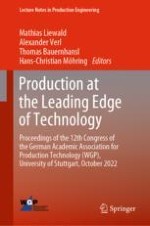2023 | Buch
Production at the Leading Edge of Technology
Proceedings of the 12th Congress of the German Academic Association for Production Technology (WGP), University of Stuttgart, October 2022
herausgegeben von: Mathias Liewald, Alexander Verl, Thomas Bauernhansl, Hans-Christian Möhring
Verlag: Springer International Publishing
Buchreihe : Lecture Notes in Production Engineering
